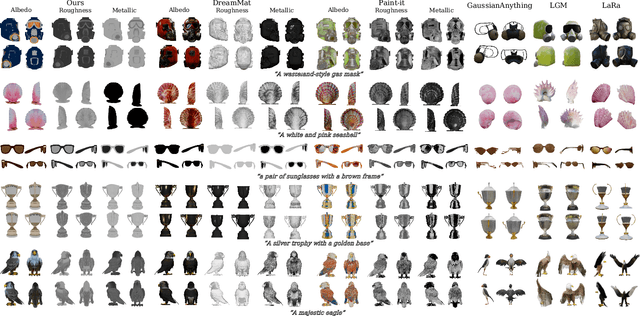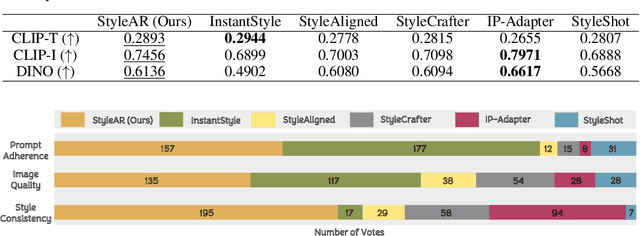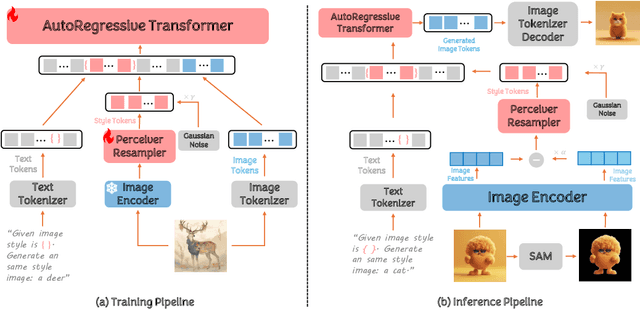Lequan Yu
Senior Member, IEEE
Variational Polya Tree
Oct 26, 2025Abstract:Density estimation is essential for generative modeling, particularly with the rise of modern neural networks. While existing methods capture complex data distributions, they often lack interpretability and uncertainty quantification. Bayesian nonparametric methods, especially the \polya tree, offer a robust framework that addresses these issues by accurately capturing function behavior over small intervals. Traditional techniques like Markov chain Monte Carlo (MCMC) face high computational complexity and scalability limitations, hindering the use of Bayesian nonparametric methods in deep learning. To tackle this, we introduce the variational \polya tree (VPT) model, which employs stochastic variational inference to compute posterior distributions. This model provides a flexible, nonparametric Bayesian prior that captures latent densities and works well with stochastic gradient optimization. We also leverage the joint distribution likelihood for a more precise variational posterior approximation than traditional mean-field methods. We evaluate the model performance on both real data and images, and demonstrate its competitiveness with other state-of-the-art deep density estimation methods. We also explore its ability in enhancing interpretability and uncertainty quantification. Code is available at https://github.com/howardchanth/var-polya-tree.
Amplifying Prominent Representations in Multimodal Learning via Variational Dirichlet Process
Oct 23, 2025Abstract:Developing effective multimodal fusion approaches has become increasingly essential in many real-world scenarios, such as health care and finance. The key challenge is how to preserve the feature expressiveness in each modality while learning cross-modal interactions. Previous approaches primarily focus on the cross-modal alignment, while over-emphasis on the alignment of marginal distributions of modalities may impose excess regularization and obstruct meaningful representations within each modality. The Dirichlet process (DP) mixture model is a powerful Bayesian non-parametric method that can amplify the most prominent features by its richer-gets-richer property, which allocates increasing weights to them. Inspired by this unique characteristic of DP, we propose a new DP-driven multimodal learning framework that automatically achieves an optimal balance between prominent intra-modal representation learning and cross-modal alignment. Specifically, we assume that each modality follows a mixture of multivariate Gaussian distributions and further adopt DP to calculate the mixture weights for all the components. This paradigm allows DP to dynamically allocate the contributions of features and select the most prominent ones, leveraging its richer-gets-richer property, thus facilitating multimodal feature fusion. Extensive experiments on several multimodal datasets demonstrate the superior performance of our model over other competitors. Ablation analysis further validates the effectiveness of DP in aligning modality distributions and its robustness to changes in key hyperparameters. Code is anonymously available at https://github.com/HKU-MedAI/DPMM.git
Large Material Gaussian Model for Relightable 3D Generation
Sep 26, 2025



Abstract:The increasing demand for 3D assets across various industries necessitates efficient and automated methods for 3D content creation. Leveraging 3D Gaussian Splatting, recent large reconstruction models (LRMs) have demonstrated the ability to efficiently achieve high-quality 3D rendering by integrating multiview diffusion for generation and scalable transformers for reconstruction. However, existing models fail to produce the material properties of assets, which is crucial for realistic rendering in diverse lighting environments. In this paper, we introduce the Large Material Gaussian Model (MGM), a novel framework designed to generate high-quality 3D content with Physically Based Rendering (PBR) materials, ie, albedo, roughness, and metallic properties, rather than merely producing RGB textures with uncontrolled light baking. Specifically, we first fine-tune a new multiview material diffusion model conditioned on input depth and normal maps. Utilizing the generated multiview PBR images, we explore a Gaussian material representation that not only aligns with 2D Gaussian Splatting but also models each channel of the PBR materials. The reconstructed point clouds can then be rendered to acquire PBR attributes, enabling dynamic relighting by applying various ambient light maps. Extensive experiments demonstrate that the materials produced by our method not only exhibit greater visual appeal compared to baseline methods but also enhance material modeling, thereby enabling practical downstream rendering applications.
A Survey of Scientific Large Language Models: From Data Foundations to Agent Frontiers
Aug 28, 2025



Abstract:Scientific Large Language Models (Sci-LLMs) are transforming how knowledge is represented, integrated, and applied in scientific research, yet their progress is shaped by the complex nature of scientific data. This survey presents a comprehensive, data-centric synthesis that reframes the development of Sci-LLMs as a co-evolution between models and their underlying data substrate. We formulate a unified taxonomy of scientific data and a hierarchical model of scientific knowledge, emphasizing the multimodal, cross-scale, and domain-specific challenges that differentiate scientific corpora from general natural language processing datasets. We systematically review recent Sci-LLMs, from general-purpose foundations to specialized models across diverse scientific disciplines, alongside an extensive analysis of over 270 pre-/post-training datasets, showing why Sci-LLMs pose distinct demands -- heterogeneous, multi-scale, uncertainty-laden corpora that require representations preserving domain invariance and enabling cross-modal reasoning. On evaluation, we examine over 190 benchmark datasets and trace a shift from static exams toward process- and discovery-oriented assessments with advanced evaluation protocols. These data-centric analyses highlight persistent issues in scientific data development and discuss emerging solutions involving semi-automated annotation pipelines and expert validation. Finally, we outline a paradigm shift toward closed-loop systems where autonomous agents based on Sci-LLMs actively experiment, validate, and contribute to a living, evolving knowledge base. Collectively, this work provides a roadmap for building trustworthy, continually evolving artificial intelligence (AI) systems that function as a true partner in accelerating scientific discovery.
AssetDropper: Asset Extraction via Diffusion Models with Reward-Driven Optimization
Jun 06, 2025Abstract:Recent research on generative models has primarily focused on creating product-ready visual outputs; however, designers often favor access to standardized asset libraries, a domain that has yet to be significantly enhanced by generative capabilities. Although open-world scenes provide ample raw materials for designers, efficiently extracting high-quality, standardized assets remains a challenge. To address this, we introduce AssetDropper, the first framework designed to extract assets from reference images, providing artists with an open-world asset palette. Our model adeptly extracts a front view of selected subjects from input images, effectively handling complex scenarios such as perspective distortion and subject occlusion. We establish a synthetic dataset of more than 200,000 image-subject pairs and a real-world benchmark with thousands more for evaluation, facilitating the exploration of future research in downstream tasks. Furthermore, to ensure precise asset extraction that aligns well with the image prompts, we employ a pre-trained reward model to fulfill a closed-loop with feedback. We design the reward model to perform an inverse task that pastes the extracted assets back into the reference sources, which assists training with additional consistency and mitigates hallucination. Extensive experiments show that, with the aid of reward-driven optimization, AssetDropper achieves the state-of-the-art results in asset extraction. Project page: AssetDropper.github.io.
StyleAR: Customizing Multimodal Autoregressive Model for Style-Aligned Text-to-Image Generation
May 26, 2025



Abstract:In the current research landscape, multimodal autoregressive (AR) models have shown exceptional capabilities across various domains, including visual understanding and generation. However, complex tasks such as style-aligned text-to-image generation present significant challenges, particularly in data acquisition. In analogy to instruction-following tuning for image editing of AR models, style-aligned generation requires a reference style image and prompt, resulting in a text-image-to-image triplet where the output shares the style and semantics of the input. However, acquiring large volumes of such triplet data with specific styles is considerably more challenging than obtaining conventional text-to-image data used for training generative models. To address this issue, we propose StyleAR, an innovative approach that combines a specially designed data curation method with our proposed AR models to effectively utilize text-to-image binary data for style-aligned text-to-image generation. Our method synthesizes target stylized data using a reference style image and prompt, but only incorporates the target stylized image as the image modality to create high-quality binary data. To facilitate binary data training, we introduce a CLIP image encoder with a perceiver resampler that translates the image input into style tokens aligned with multimodal tokens in AR models and implement a style-enhanced token technique to prevent content leakage which is a common issue in previous work. Furthermore, we mix raw images drawn from large-scale text-image datasets with stylized images to enhance StyleAR's ability to extract richer stylistic features and ensure style consistency. Extensive qualitative and quantitative experiments demonstrate our superior performance.
Feature Preserving Shrinkage on Bayesian Neural Networks via the R2D2 Prior
May 23, 2025Abstract:Bayesian neural networks (BNNs) treat neural network weights as random variables, which aim to provide posterior uncertainty estimates and avoid overfitting by performing inference on the posterior weights. However, the selection of appropriate prior distributions remains a challenging task, and BNNs may suffer from catastrophic inflated variance or poor predictive performance when poor choices are made for the priors. Existing BNN designs apply different priors to weights, while the behaviours of these priors make it difficult to sufficiently shrink noisy signals or they are prone to overshrinking important signals in the weights. To alleviate this problem, we propose a novel R2D2-Net, which imposes the R^2-induced Dirichlet Decomposition (R2D2) prior to the BNN weights. The R2D2-Net can effectively shrink irrelevant coefficients towards zero, while preventing key features from over-shrinkage. To approximate the posterior distribution of weights more accurately, we further propose a variational Gibbs inference algorithm that combines the Gibbs updating procedure and gradient-based optimization. This strategy enhances stability and consistency in estimation when the variational objective involving the shrinkage parameters is non-convex. We also analyze the evidence lower bound (ELBO) and the posterior concentration rates from a theoretical perspective. Experiments on both natural and medical image classification and uncertainty estimation tasks demonstrate satisfactory performance of our method.
MedAgentBoard: Benchmarking Multi-Agent Collaboration with Conventional Methods for Diverse Medical Tasks
May 18, 2025Abstract:The rapid advancement of Large Language Models (LLMs) has stimulated interest in multi-agent collaboration for addressing complex medical tasks. However, the practical advantages of multi-agent collaboration approaches remain insufficiently understood. Existing evaluations often lack generalizability, failing to cover diverse tasks reflective of real-world clinical practice, and frequently omit rigorous comparisons against both single-LLM-based and established conventional methods. To address this critical gap, we introduce MedAgentBoard, a comprehensive benchmark for the systematic evaluation of multi-agent collaboration, single-LLM, and conventional approaches. MedAgentBoard encompasses four diverse medical task categories: (1) medical (visual) question answering, (2) lay summary generation, (3) structured Electronic Health Record (EHR) predictive modeling, and (4) clinical workflow automation, across text, medical images, and structured EHR data. Our extensive experiments reveal a nuanced landscape: while multi-agent collaboration demonstrates benefits in specific scenarios, such as enhancing task completeness in clinical workflow automation, it does not consistently outperform advanced single LLMs (e.g., in textual medical QA) or, critically, specialized conventional methods that generally maintain better performance in tasks like medical VQA and EHR-based prediction. MedAgentBoard offers a vital resource and actionable insights, emphasizing the necessity of a task-specific, evidence-based approach to selecting and developing AI solutions in medicine. It underscores that the inherent complexity and overhead of multi-agent collaboration must be carefully weighed against tangible performance gains. All code, datasets, detailed prompts, and experimental results are open-sourced at https://medagentboard.netlify.app/.
Proxy-Tuning: Tailoring Multimodal Autoregressive Models for Subject-Driven Image Generation
Mar 13, 2025



Abstract:Multimodal autoregressive (AR) models, based on next-token prediction and transformer architecture, have demonstrated remarkable capabilities in various multimodal tasks including text-to-image (T2I) generation. Despite their strong performance in general T2I tasks, our research reveals that these models initially struggle with subject-driven image generation compared to dominant diffusion models. To address this limitation, we introduce Proxy-Tuning, leveraging diffusion models to enhance AR models' capabilities in subject-specific image generation. Our method reveals a striking weak-to-strong phenomenon: fine-tuned AR models consistently outperform their diffusion model supervisors in both subject fidelity and prompt adherence. We analyze this performance shift and identify scenarios where AR models excel, particularly in multi-subject compositions and contextual understanding. This work not only demonstrates impressive results in subject-driven AR image generation, but also unveils the potential of weak-to-strong generalization in the image generation domain, contributing to a deeper understanding of different architectures' strengths and limitations.
Democratizing Large Language Model-Based Graph Data Augmentation via Latent Knowledge Graphs
Feb 19, 2025Abstract:Data augmentation is necessary for graph representation learning due to the scarcity and noise present in graph data. Most of the existing augmentation methods overlook the context information inherited from the dataset as they rely solely on the graph structure for augmentation. Despite the success of some large language model-based (LLM) graph learning methods, they are mostly white-box which require access to the weights or latent features from the open-access LLMs, making them difficult to be democratized for everyone as existing LLMs are mostly closed-source for commercial considerations. To overcome these limitations, we propose a black-box context-driven graph data augmentation approach, with the guidance of LLMs -- DemoGraph. Leveraging the text prompt as context-related information, we task the LLM with generating knowledge graphs (KGs), which allow us to capture the structural interactions from the text outputs. We then design a dynamic merging schema to stochastically integrate the LLM-generated KGs into the original graph during training. To control the sparsity of the augmented graph, we further devise a granularity-aware prompting strategy and an instruction fine-tuning module, which seamlessly generates text prompts according to different granularity levels of the dataset. Extensive experiments on various graph learning tasks validate the effectiveness of our method over existing graph data augmentation methods. Notably, our approach excels in scenarios involving electronic health records (EHRs), which validates its maximal utilization of contextual knowledge, leading to enhanced predictive performance and interpretability.
 Add to Chrome
Add to Chrome Add to Firefox
Add to Firefox Add to Edge
Add to Edge